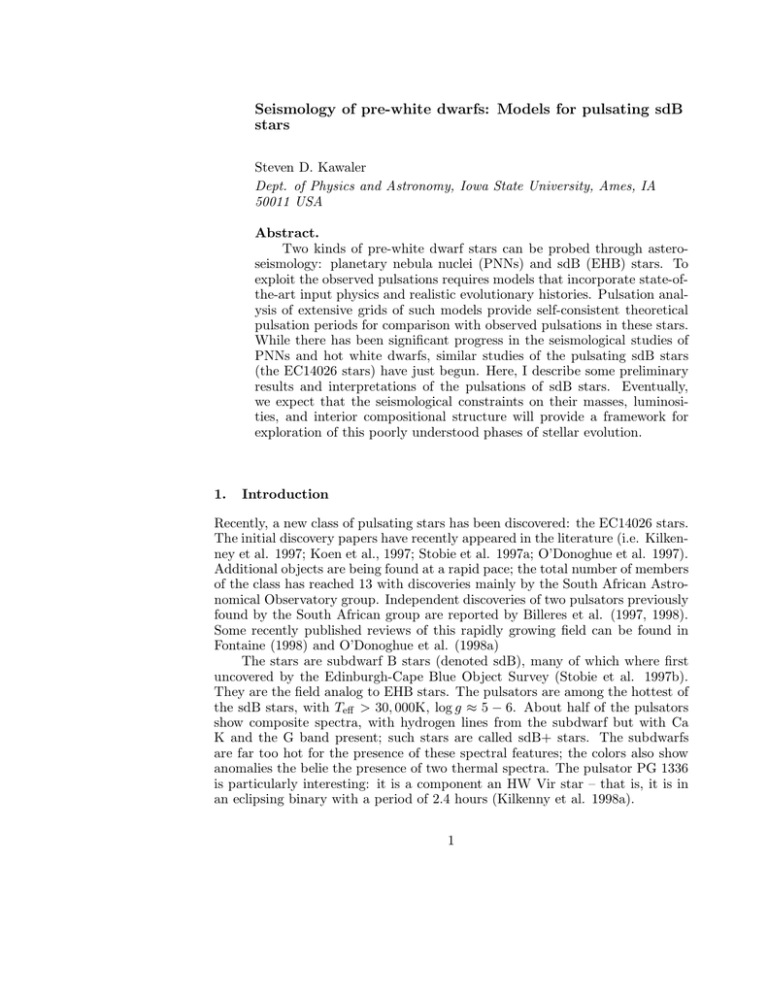Seismology of pre-white dwarfs: Models for pulsating sdB stars
advertisement

Seismology of pre-white dwarfs: Models for pulsating sdB stars Steven D. Kawaler Dept. of Physics and Astronomy, Iowa State University, Ames, IA 50011 USA Abstract. Two kinds of pre-white dwarf stars can be probed through asteroseismology: planetary nebula nuclei (PNNs) and sdB (EHB) stars. To exploit the observed pulsations requires models that incorporate state-ofthe-art input physics and realistic evolutionary histories. Pulsation analysis of extensive grids of such models provide self-consistent theoretical pulsation periods for comparison with observed pulsations in these stars. While there has been significant progress in the seismological studies of PNNs and hot white dwarfs, similar studies of the pulsating sdB stars (the EC14026 stars) have just begun. Here, I describe some preliminary results and interpretations of the pulsations of sdB stars. Eventually, we expect that the seismological constraints on their masses, luminosities, and interior compositional structure will provide a framework for exploration of this poorly understood phases of stellar evolution. 1. Introduction Recently, a new class of pulsating stars has been discovered: the EC14026 stars. The initial discovery papers have recently appeared in the literature (i.e. Kilkenney et al. 1997; Koen et al., 1997; Stobie et al. 1997a; O’Donoghue et al. 1997). Additional objects are being found at a rapid pace; the total number of members of the class has reached 13 with discoveries mainly by the South African Astronomical Observatory group. Independent discoveries of two pulsators previously found by the South African group are reported by Billeres et al. (1997, 1998). Some recently published reviews of this rapidly growing field can be found in Fontaine (1998) and O’Donoghue et al. (1998a) The stars are subdwarf B stars (denoted sdB), many of which where first uncovered by the Edinburgh-Cape Blue Object Survey (Stobie et al. 1997b). They are the field analog to EHB stars. The pulsators are among the hottest of the sdB stars, with Teff > 30, 000K, log g ≈ 5 − 6. About half of the pulsators show composite spectra, with hydrogen lines from the subdwarf but with Ca K and the G band present; such stars are called sdB+ stars. The subdwarfs are far too hot for the presence of these spectral features; the colors also show anomalies the belie the presence of two thermal spectra. The pulsator PG 1336 is particularly interesting: it is a component an HW Vir star – that is, it is in an eclipsing binary with a period of 2.4 hours (Kilkenny et al. 1998a). 1 It is very clear that the EC14026 stars are highly evolved. They lie at the extreme blue end of the horizontal branch (HB). Those with high gravity (all but PG 1605) fall quite close to the helium–burning main sequence (see below). Of the above stars, two (PB 8783 and PG 1605) have been the subjects of global observing campaigns (O’Donoghue et al. 1998b, Kilkenny et al. 1998b). 2. The two (or three) flavors of EC14026 Stars Vanilla is the best description of the “high gravity” EC14026 stars; they all have periods between 100 and 180 seconds, and show a relatively small number of modes (10 or less). The star PG 1605 is perhaps the triple–chocolate gelato of the EC14026 stars: it has the lowest gravity (log g = 5.25 ± 0.10), longest periods (to above 500 seconds) and richest pulsation spectrum, by far (Koen et al. 1998a). Feige 48 is, perhaps, vanilla fudge; it shows several periods near 340350 seconds, but is not nearly as rich as PG 1605. It also has an intermediate gravity of 5.45 ± 0.05, and is the coolest of the class with Teff = 28, 900 (Koen et al. 1998b). As we next show, the more advanced evolutionary status of PG 1605 actually simplifies, to some extent, the critical step of mode identification. Because of its high degree of central concentration, it can trap nonradial modes, and concentrate mode periods in several bunches. The close correspondence between the periods of the trapped modes and those seen in the star is the key. 3. Evolutionary models of EHB stars To be as hot as observed requires that these stars have lost nearly all of their outer hydrogen layers; the mass fraction of the core must be in excess of 0.9995 for them to correspond to any reasonable evolutionary track. (The properties of sdB stars in general are described by Saffer et al. 1994). The hot sdB stars are enigmatic in the sense that their origin is not well understood. Horizontal branch stars in clusters indicate that there is indeed a distribution in the total mass lost along the red giant branch and during the helium flash, but the number of know sdB and EHB stars with very thin (but nonzero) surface hydrogen layers remains a mystery. D’Cruz et al (1996) show one possible mechanism for producing EHB stars as a consequence of steady mass loss on the RGB prior to the helium flash. The fact that half of the pulsators are sdB+ stars raises other questions about the possible binary interactions involved in their formation, and by extension, the relevance of binary interaction to the question of origin of all hot subdwarfs and EHB stars. Whatever their origin, their placement in the H–R diagram on and near the EHB makes modeling them relatively straightforward. Modeling of EHB stars follows the same procedures as normal HB stars. It is assumed that the helium core has a mass corresponding to that at the helium core flash, and that helium burning proceeds quiescently. The thickness of the envelope, taken as a free parameter, determines the position along the ZAEHB, with thinner envelopes corresponding to hotter ZAEHB models. Evolution off of the ZAEHB involves a growing convective core, which eventually establishes a semiconvective region. 2 5 5.5 Z=0.01 Mc=0.470Mo 6 45 40 35 30 25 20 Te/1000 Figure 1. The pulsating EC14026 stars in the log g-Teff plane. Open circles: ZAHeMS. Masses from 0.57M and 0.41M (from high to low Teff ). Dotted line: ZAEHB models with the 0.47M He core. Evolutionary tracks: models with hydrogen envelopes of (left to right) 0.0001, 0.001, 0.002, and 0.004, and 0.008 M . PG 1605 clearly lies above the main EHB, at a point where the models have exhausted their core helium. Figure 1 shows the positions of the EC14026 stars in a log g-Teff diagram, along with some preliminary stellar models computed by the PI. The Zero Age Helium Main Sequence (ZAHeMS) for models with Z = 0.01 is shown, as are models with a representative core mass of 0.470M and various amounts of hydrogen. EHB models evolve vertically off of the ZAEHB (in the log g-Teff plane) until the core helium abundance drops to about 20-30% by mass, after which the star quickly evolves to higher Teff . We note that the models shown in Figure 1 were computed under the recent ATP grant; they are the first ones designed for pulsation studies to evolve through the observed positions of the EC14026 stars in the H–R diagram. They are described briefly in Stobie et al. (1997a), Kilkenny et al (1998b), and Kawaler (1998b). The pulsation periods in the range from 100 to 200 seconds correspond to low–order radial and nonradial modes in EHB models. Stobie et al. (1997a) and Kilkenny et al. (1998b) compare the observed periods to those of models, and conclude that the periods present in each star cannot be explained by purely radial modes. Clearly mode identifications will depend on more accurate determinations of the fundamental parameters of the stars, but the general agreement between the models and the observed periods is good. In the next section, we report on new results for PG 1605, the lowest–gravity EC 14026 star, where the match is very close. 3 4. Pulsation properties of evolved models: mode trapping 5. A fit for PG 1605 Figure 1 shows an evolutionary track for a 0.4740M model that passes directly through the spectroscopic error box for the low–gravity star PG 1605. Computing pulsation periods for models within the error box, we have recently found that one model naturally fits the dominant pulsation modes in this star to relatively high precision (see Table 1). This model has a mass of 0.4740M , a hydrogen shell of 0.004M , has an effective temperature of 31,500K and a log g of 5.33. Slight changes in the age of this model (which has exhausted helium in its core) destroy the fit to the observations. In this fit, rotational splitting produces peaks 1 and 3. Peaks 2 and 5, with n = 7 correspond nearly exactly to “trapped modes”. These are nonradial modes which have frequencies that are very close to the fundamental and first–overtone radial modes. Such mode trapping has been explored in RR Lyra models (van Hoolst, Dziembowski & Kawaler 1998), and may play an important role in this sdB star. Table 1. Comparison of observed large–amplitude pulsation periods in PG 1605 with an evolutionary model Number 1 2 3 4 5 Period [s] Star Model 528.7 s 531.3 s 481.8 s 482.8 s 440.5 s 442.3 s 475.8 s 471.8 s 364.6 s 364.2 s ` 1 1 1 2 1 Mode n m 7 -1 7 0 7 +1 13 0 4 0 If we ignore all of the low–amplitude peaks in the power spectrum of PG 1605 (since they may result from amplutide modulation and not separate normal modes), we are left with 5 main peaks. We compare these with the periods of the low–order radial modes, and trapped nonradial modes, for models with similar Teff and gravity. 6. Discussion Acknowledgments. It is a pleasure to thank Darragh O’Donoghue, Chris Koen, and Dave Kilkenny for many stimulating discussions, and for keeping this cow from straying too far from the herd by continually mending fences. Just one hole left, guys, but you can plug it by measuring the rotation velocity of PG 1605. References Kilkenny, D., et al. 1997, MNRAS, 285, 640. 4 Kilkenny, D., et al. 1998a, MNRAS, 296, 329. Kilkenny, D., et al. 1998b, MNRAS, in press. Koen, C., Kilkenny, D., O’Donoghue, D., Van Wyk, F., & Stobie, R. 1997, MNRAS, 285, 645. Koen, C., O’Donoghue, D., Kilkenny, D., Lynas–Gray, A.E., Marang, F., & van Wyk, F. 1998a, MNRAS 296, 317 Koen, C., O’Donoghue, D., Pollacco, D.L., & Nitta, A. 1998b, MNRAS 300, 1105 O’Donoghue, D. 1998, these proceedings O’Donoghue, D., et al. 1997, MNRAS, 285, 657. O’Donoghue, D., et al. 1998a, Balt. Astron., 7, 313 O’Donoghue, D., et al. 1998b, MNRAS, 296, 296. Van Hoolst, T., Dziembowski, W.A., & Kawaler, S.D. 1998, MNRAS, 297, 536 5






